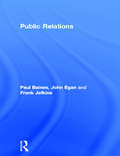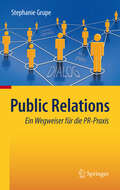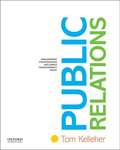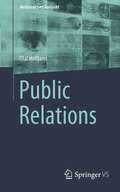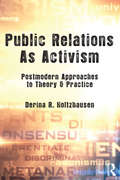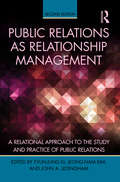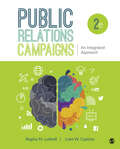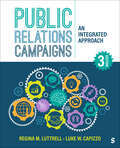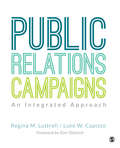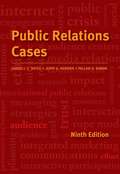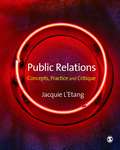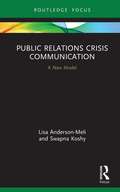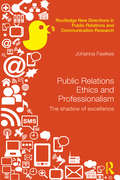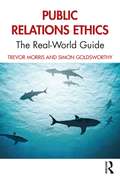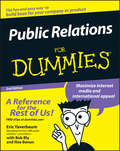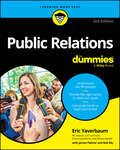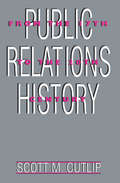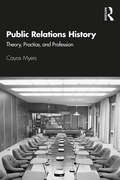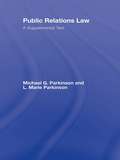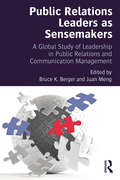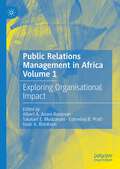- Table View
- List View
Public Radio and Television in America: A Political History
by Ralph EngelmanThe origins and evolution of the major insititutions in the United States for noncommercial radio and television are explored in this unique volume. Ralph Engelman examines the politics behind the development of National Public Radio, Radio Pacifica and the Public Broadcasting Service. He traces the changing social forces that converged to launch and shape these institutions from the Second World War to the present day. The book challenges several commonly held beliefs - including that the mass media is simply a manipulative tool - and concludes that public broadcasting has an enormous potential as an emancipatory vehicle.
Public Relations
by Paul Baines John Egan Frank JefkinsPublic Relations: contemporary issues and techniques offers a definitive guide to public relations management. It provides comprehensive analysis and explanation of a full range of modern PR techniques, spanning both inhouse and agency practice.The text has involved fundamental restructuring and updating of existing material and the incorporation of the new techniques and strategies, for instance:* The use of multimedia techniques in PR* Overseas media and the globalization of media communications* The latest case examples - notably New Labour's rebranding and media management since 1997, government PR during the 2001 war against Afghanistan, and the 2002 football World CupThe book presents the core strategies for successful PR combining this with indepth advice on implementation and the everyday techniques that every PR person needs to grasp. With a range of new user-friendly textual features, the book's practical, how-to focus, wedded to firm theoretical analysis, makes it the ideal text for those studying for professionally accredited examinations such as the IPR, CAM and LCCI awards. It is also a useful aide-memoire for all practising PR professionals.
Public Relations
by Stephanie GrupeErfolgreiche Öffentlichkeitsarbeit basiert auf der sorgfältigen Planung und Ausführung von praxiserprobten Maßnahmen. Das Buch liefert Grundlagenwissen zusammen mit Arbeitsanleitungen für die Praxis. Leser erfahren, wie PR strategisch geplant, wie Pressekampagnen durchgeführt und kontrolliert werden, wie Mitarbeiterzeitungen herausgegeben und Webseiten für die Kommunikation eingesetzt werden. Mit 15 einfachen, schnell nachvollziehbaren Schritt-für-Schritt Anleitungen für Einsteiger sowie Checklisten und Musteraufgaben für die tägliche PR-Arbeit.
Public Relations
by Tom KelleherPublic Relations presents a clear, engaging and contemporary picture of public relations principles while seamlessly integrating technical and cultural shifts brought about by the rise of social media. Both its professional relevance and digital savvy make Public Relations the new standard for introductory public relations courses.
Public Relations (Medienwissen kompakt)
by Olaf HoffjannWährend Werber mit ästhetischen Spots und humorvollen Anzeigen das Publikum unterhalten, bleiben PR-PraktikerInnen im Halbdunkel der Hinterbühne. In dem Band soll diese Hinterbühne ausgeleuchtet werden. Zunächst wird erklärt, was man genau unter Public Relations verstehen kann und was sie von der Werbung unterscheidet. Pressesprecher zielen mit ihren vielfältigen Angeboten auf JournalistInnen und versuchen so, die Berichterstattung zu beeinflussen. Während manche davon ausgehen, dass sie einen Großteil der Berichterstattung kontrollieren, sehen andere eine größere Macht bei den Journalisten. Mit ihren wünschenswerten Wirklichkeiten versucht die PR, schöne und vor allem tadellose Fassaden zu errichten, die nicht immer etwas mit dem unternehmerischen Handeln hinter dieser Fassade zu tun haben müssen. Viele PR-Skandale der vergangenen Jahre zeigen, wie PR versucht hat, Verfehlungen oder Störfälle zu verharmlosen oder gar zu verheimlichen. Die Digitalisierung ermöglicht der PR ganz neue Möglichkeiten: Video-Kanäle, soziale Netzwerke und digitale Influencer sind neue Wege, die Zielgruppen zu erreichen. Und nicht selten führt dies dazu, dass etablierte JournalistInnen an den Rand gedrängt werden.
Public Relations As Activism: Postmodern Approaches to Theory & Practice (Routledge Communication Series)
by Derina R. HoltzhausenThis volume applies postmodern theory to public relations, providing an alternative lens to public relations theory and practice and developing public relations theory within the context of postmodernism. Author Derina R. Holtzhausen focuses on two key issues and their application to public relations theory and practice: the postmodernization of society, and the possibilities postmodern theories offer to explain and understand public relations practice in today’s changing society. Holtzhausen's argument is that existing theory should be evaluated from a postmodern perspective to determine its applicability to postmodernity. Utilizing practitioner perspectives throughout the volume, she explores the practice of public relations as a form of activism. The volume is intended for scholars and students in public relations. It may be used as a supplemental text in advanced courses on public relations theory, PR management, organizational communication, and related areas.
Public Relations As Relationship Management: A Relational Approach To the Study and Practice of Public Relations (Routledge Communication Series)
by Eyun-Jung Ki Jeong-Nam Kim John A. LedinghamThe emergence of relationship management as a paradigm for public relations scholarship and practice necessitates an examination of precisely what public relations achieves -- its definition, function and value, and the benefits it generates. Promoting the view that public relations provides value to organizations, publics, and societies through relationships, Public Relations as Relationship Management takes a in-depth look at organization-public relationships and explores the strategies that can be employed to cultivate and maintain them. Expanding on the work published in the first edition, this thoroughly up-to-date volume covers such specialized areas of public relations as non-profit organizations, shareholder relations, lobbying, employee relations, and risk management. It expands the reader’s ability to understand, conceptualize, theorize, and measure public relations through the presentation of state-of-the-art research and examples of the use of the relationship paradigm. Developed for scholars, researchers, and advanced students in public relations, Public Relations as Relationship Management provides a contemporary perspective on the role of relationships in public relations, and encourages further research and study.
Public Relations Campaigns: An Integrated Approach
by Regina M. Luttrell Luke W. CapizzoWith a focus on the tools needed for working in the PR industry, Public Relations Campaigns: An Integrated Approach gives students a hands-on introduction to creating successful, integrated PR campaigns. Authors Regina M. Luttrell and Luke W. Capizzo present the ROSTIR model (research/diagnosis, objectives, strategy, tactics, implementation, and reporting/evaluation) and PESO model (paid, earned, shared/social, and owned media) to show students a framework for practitioners to plan effectively and use all of the resources available to them to create winning campaigns. The Second Edition emphasizes the importance of diversity initiatives and teaches students how to integrate a cross-cultural approach to PR strategies.
Public Relations Campaigns: An Integrated Approach
by Regina M. Luttrell Luke W. CapizzoWith a focus on the tools needed for working in the PR industry, Public Relations Campaigns: An Integrated Approach gives students a hands-on introduction to creating successful, integrated PR campaigns. Authors Regina M. Luttrell and Luke W. Capizzo present the ROSTIR model (research/diagnosis, objectives, strategy, tactics, implementation, and reporting/evaluation) and PESO model (paid, earned, shared/social, and owned media) to show students a framework for practitioners to plan effectively and use all of the resources available to them to create winning campaigns. The Second Edition emphasizes the importance of diversity initiatives and teaches students how to integrate a cross-cultural approach to PR strategies.
Public Relations Campaigns: An Integrated Approach
by Regina M. Luttrell Luke W. CapizzoPublic Relations Campaigns: An Integrated Approach introduces students to the process of creating public relations campaigns using a hands-on approach that emphasizes the tools students will need when working in the industry. Authors Regina M. Luttrell and Luke W. Capizzo present real examples and current case studies to help students develop practical skills for creating more effective PR campaigns. Students are given multiple opportunities to practice and build their skills throughout the book by learning how to apply the PESO model—Paid media, Earned media, Social media, and Owned media—to concept cases. The Third Edition emphasizes the importance of diversity initiatives and further highlights an integrated approach that encompasses aspects of social media, marketing, advertising, and client management for a broader view of the campaign planning process.
Public Relations Campaigns: An Integrated Approach
by Regina M. Luttrell Luke W. CapizzoPublic Relations Campaigns: An Integrated Approach introduces students to the process of creating public relations campaigns using a hands-on approach that emphasizes the tools students will need when working in the industry. Authors Regina M. Luttrell and Luke W. Capizzo present real examples and current case studies to help students develop practical skills for creating more effective PR campaigns. Students are given multiple opportunities to practice and build their skills throughout the book by learning how to apply the PESO model—Paid media, Earned media, Social media, and Owned media—to concept cases. The Third Edition emphasizes the importance of diversity initiatives and further highlights an integrated approach that encompasses aspects of social media, marketing, advertising, and client management for a broader view of the campaign planning process.
Public Relations Campaigns: An Integrated Approach
by Ms Regina M. Luttrell Mr Luke W. CapizzoPublic Relations Campaigns: An Integrated Approach introduces you to the process of creating public relations campaigns using a hands-on approach that emphasizes the tools you will need when working in the industry. Authors Regina M. Luttrell and Luke W. Capizzo present real examples and current case studies to help you develop practical skills for creating more effective PR campaigns. You are given multiple opportunities to practice and build your skills throughout the book by learning how to incorporate the PESO model—Paid media, Earned media, Social media, and Owned media. The PESO model helps students understand the importance of creating integrated campaigns that coordinate PR efforts with both advertising and marketing. Key Features The book offers a timely focus on the PESO model and its use in integrated campaigns, providing students with an understanding of today’s best practices in PR. Numerous case studies and exercises throughout the book aid in a deeper understanding of how research, perspective, and insights can be leveraged in public relations campaigns. Real-world information including sample PR plans with budgets prepare students for success in their future careers.
Public Relations Campaigns: An Integrated Approach
by Ms Regina M. Luttrell Mr Luke W. CapizzoPublic Relations Campaigns: An Integrated Approach introduces you to the process of creating public relations campaigns using a hands-on approach that emphasizes the tools you will need when working in the industry. Authors Regina M. Luttrell and Luke W. Capizzo present real examples and current case studies to help you develop practical skills for creating more effective PR campaigns. You are given multiple opportunities to practice and build your skills throughout the book by learning how to incorporate the PESO model—Paid media, Earned media, Social media, and Owned media. The PESO model helps students understand the importance of creating integrated campaigns that coordinate PR efforts with both advertising and marketing. Key Features The book offers a timely focus on the PESO model and its use in integrated campaigns, providing students with an understanding of today’s best practices in PR. Numerous case studies and exercises throughout the book aid in a deeper understanding of how research, perspective, and insights can be leveraged in public relations campaigns. Real-world information including sample PR plans with budgets prepare students for success in their future careers.
Public Relations Cases
by Darrell C. Hayes Jerry A. Hendrix Pallavi D. KumarThe case studies provide glimpses into best practices for public relations campaigns as recognized by professionals in the field. The cases all use a strategic communications model, where clearly defined objectives are based on sound research and good audience analysis, followed by creative tactics that are evaluated for their effectiveness.
Public Relations Concepts, Practice and Critique: Concepts, Practice and Critique
by Jacquie L'EtangThis textbook aims to introduce students to key concepts in public relations, using a wide range of interdisciplinary sources, as well as teaching students how to think critically about public relations. It is designed to help readers understand the paradigms which have shaped the discipline and the practice. The book is intended to be accessible, engaging, quirky, and fun. The book helps students engage with difficult questions about public relations. Readers are encouraged to reflect upon their own relationship with the occupation through exercises, critical reflections, questions for discussion, and vignettes. Students are helped to widen their intellectual perspective on the subject of public relations through ‘discipline boxes’ which explain source domains, their origins and approaches, and connections to public relations.
Public Relations Crisis Communication: A New Model (Routledge Focus on Business and Management)
by Lisa Anderson-Meli Swapna KoshyThis book explores the definition, nature and context of public relations crises; it also examines and defines the main elements of public relations crises and positions it in the context of the current communication sphere. Public Relations Crisis Communication: A New Model investigates existing group communication theories, including organizational culture, critical theory of organizations, media ecology, public rhetoric, and cross-cultural communication theory to establish their relevance in the context of the new model of public relations crisis. Key concepts from existing public relations crisis theory are also discussed and validated in order to establish prevailing thought. Through a case study of Malaysia Airlines MH370, involving a textual analyses of press communications on the Malaysia Airlines website, this book scrutinises prevailing theory and definitions. Most valuably, this book proposes a new definition and model of public relations crisis, alongside a suggested extension to existing crisis communication theory in the form of a hierarchy of publics to be addressed during crises. This will help to address divergent publics with differing priorities in public relations crisis communication. This book is of interest to students, teachers, researchers and practitioners of public relations, communication, media and marketing, as well as professionals in the aviation industry and international relations.
Public Relations Ethics and Professionalism: The Shadow of Excellence (Routledge New Directions in PR & Communication Research)
by Johanna FawkesDo professions really place duty to society above clients' or their own interests? If not, how can they be trusted? While some public relations (PR) scholars claim that PR serves society and enhances the democratic process, others suggest that it is little more than propaganda, serving the interests of global corporations. This is not an argument about definitions, but about ethics - yet this topic is barely explored in texts and theories that seek to explain PR and its function in society. This book places PR ethics in the wider context of professional ethics and the sociology of professions. By bringing together literature from fields beyond public relations - sociology, professional and philosophical ethics, and Jungian psychology - it integrates a new body of ideas into the debate. The unprecedented introduction of Jungian psychology to public relations scholarship shifts the debate beyond a traditional Western 'Good/Bad' ethical dichotomy towards a new holistic approach, with dynamic implications for theory and practice. This thought-provoking book will be essential reading for students, academics and professionals with an interest in public relations, ethics and professionalism.
Public Relations Ethics: The Real-World Guide
by Trevor Morris Simon GoldsworthyThis book is a pragmatic, case-rich guide to how current and future public relations practitioners can apply ethical principles and the industry’s codes of ethics to their day-to-day work. Authors Trevor Morris and Simon Goldsworthy draw on their years of industry and academic experience to illustrate key ethical issues and ground them in reality, all within an international frame of reference. Public Relations Ethics incorporates interviews with industry practitioners, offering contrasting perspectives as well as recent examples of real-life complaints and disciplinary issues. Provocative questions and exercises help readers grapple with ethical dilemmas and review the key scenarios and challenges that PR people face. The book is ideal at the undergraduate, postgraduate and continuing education levels as a core text for public relations ethics courses and a supplementary text for general public relations survey courses. Accompanying the text are online resources for both students and instructors, including lecture slides and links to further resources.
Public Relations For Dummies
by Ilise Benun Eric YaverbaumProven techniques that maximize media exposure for your business A seasoned PR pro shows you how to get people talking When it comes to public relations, nothing beats good word of mouth. Want to get customers talking? This friendly guide combines the best practical tools with insight and flair to provide guidance on every aspect of PR, so you can launch a full-throttle campaign that'll generate buzz -- and build your bottom line. Discover how to * Map a winning PR strategy * Grab attention with press releases, interviews, and events * Cultivate good media relations * Get print, TV, radio, and Internet coverage * Manage a PR crisis
Public Relations For Dummies
by Eric YaverbaumUnderstand what it takes to develop successful public relations campaigns Effective public relations (PR) can help level the playing field between you and your competitors. You don't necessarily need a big budget to establish brand awareness and a positive reputation. With enough practice, anyone can learn to think like a PR specialist. Public Relations For Dummies helps you understand the mechanics of PR and gives you all the tools you need to succeed. This friendly guide gives you practical insights on using the many components of PR to create successful campaigns. You'll learn how to assemble a PR plan, create a budget, develop winning ideas, cultivate media contacts, create pitches, leverage social media and podcasts, secure public speaking engagements, and beyond. Plus, this new edition covers the latest technology for reaching more people and analyzing your results. No business jargon in this book—just clear, simple information and advice on making PR work for you. Understand the purpose and process of public relations management Choose the right PR tactics to meet your specific goals Use social media, including TikTok, to your advantage Connect with people who can help you build your brand's reputation This Dummies guide is great for small business owners and people who want to learn more about doing PR for larger companies. Nonprofit organizations and influencers will also love these tips on getting noticed.
Public Relations History: The Antecedents (Routledge Communication Series)
by Scott M. CutlipThis important volume documents events and routines defined as public relations practice, and serves as a companion work to the author's The Unseen Power: Public Relations which tells the history of public relations as revealed in the work and personalities of the pioneer agencies. This history opens with the 17th Century efforts of land promoters and colonists to lure settlers from Europe -- mainly England -- to this primitive land along the Atlantic Coast. They used publicity, tracts, sermons, and letters to disseminate rosy, glowing accounts of life and opportunity in the new land. The volume closes with a description of the public relations efforts of colleges and other non-profit agencies in the late 19th and early 20th centuries, thus providing a bridge across the century line. This study of the origins of public relations provides helpful insight into its functions, its strengths and weaknesses, and its profound though often unseen impact on our society. Public relations or its equivalents -- propaganda, publicity, public information -- began when mankind started to live together in tribal camps where one's survival depended upon others of the tribe. To function, civilization requires communication, conciliation, consensus, and cooperation -- the bedrock fundamentals of the public relations function. This volume is filled with robust public struggles -- the struggles of which history is made and a nation built: * the work of the Revolutionaries, led by the indomitable Sam Adams, to bring on the War of Independence that gave birth to a New Nation; * the propaganda of Alexander Hamilton, James Madison, and John Jay in the Federalist papers to win ratification of the U.S. Constitution -- prevailing against the propaganda of the AntiFederalists led by Richard Henry Lee; * the battle between the forces of President Andrew Jackson, led by Amos Kendall, and those of Nicholas Biddle and his Bank of the United States which presaged corporate versus government campaigns common today: * the classic presidential campaign of 1896 which pitted pro-Big Business candidate William McKinley against the Populist orator of the Platte, William Jennings Bryan. This book details the antecedents of today's flourishing, influential vocation of public relations whose practitioners -- some 150,000 professionals -- make their case for their clients or their employers in the highly competitive public opinion marketplace.
Public Relations History: Theory, Practice, and Profession
by Cayce MyersThis book presents a unique overview of public relations history, tracing the development of the profession and its practices in a variety of sectors, ranging from politics, education, social movements, and corporate communication to entertainment. Author Cayce Myers examines the institutional pressures, including financial, legal, and ethical considerations, that have shaped public relations and have led to the parameters in which the practice is executed today, exploring the role that underrepresented groups and sectors (both in the U.S. and internationally) played in its formation. The book presents the diversity and nuance of public relations practice while also providing a cohesive narrative that engages readers in the complex development of this influential profession. Public Relations History is an excellent resource for upper-level undergraduate and graduate courses covering public relations theory, management, and administration; mass communication history; and media history.
Public Relations Law: A Supplemental Text
by Michael G. Parkinson L. Marie ParkinsonThis supplemental text on PR law is intended to be used with other mass communication textbooks. It is intended for the mass communication law course, which is a mainstay in all accredited programs in mass communication, journalism, broadcasting, telecommunications, public relations, mass media, and related curricula.
Public Relations Leaders as Sensemakers: A Global Study of Leadership in Public Relations and Communication Management
by Bruce K. Berger Juan MengPublic Relations Leaders as Sensemakers presents foundational research on the public relations profession, providing a current and compelling picture of expanding global practice. Utilizing data from one of the largest studies ever conducted in the field, and representing the perspectives of 4,500 practitioners, private and state-run companies, communication agencies, government agencies, and nonprofits, this work advances a theory of integrated leadership in public relations and highlights future research needs and educational implications. This volume is appropriate for graduate and advanced undergraduate students in international public relations and communication management, as well as scholars in global public relations, communication management, and business. It is also intended to supplement courses in public relations theory, strategic communication, business management, and leadership development.
Public Relations Management in Africa Volume 1: Exploring Organisational Impact
by Cornelius B. Pratt Albert A. Anani-Bossman Takalani E. Mudzanani Isaac A. BlanksonThis two-part volume examines current pedagogical modules, research directions and other emerging issues in public relations and communication management in Africa. In comparison to its Western and Asian counterparts, the literature on public relations management in Africa is limited, and much of it is examined through the lenses of Western philosophies and pedagogies that do not generally resonate with Africa's socioeconomic, political, and cultural contexts. This book aims to change that. Through analyzing the organizational dynamic, Volume 1 brings together contributors from across Africa to provide valuable insights into how public relations contributes to organizational effectiveness on the continent. Chapters discussed include a review of public relations research in Africa, the role of the African CEO as a public relations activist, the use of social and digital media in public relations, the measurement and evaluation of communication programs, and the implications of the fourth industrial revolution on public relations practice in Africa. Providing important pathways and overviews of public relations management in Africa, this volume not only highlights current practices but offers insights into the future of the practice within its evolving global landscape.

